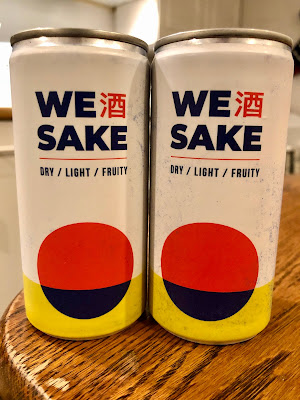Sake in a can? Japanese Sake, especially in Japan, comes in a variety of different packagings, from cans to tetra-paks. It's also not just inexpensive Sake that comes in these alternative packagings. Premium Sake, the top 25% of all Sake, can be found in cans and tetra-paks. Some of those alternative packagings are available in the U.S. and I've previously enjoyed a number of them.
The rice for this Sake is grown in Tagocho, by local farmers, although the type of rice is not identified. Then, the Sake is said to be brewed by a "280 year old brewery in Kobe, Japan." That brewery is not specifically identified although it's likely Hakutsuru Brewery, which was founded in 1743, and will thus be 280 years old next year.
As a Junmai Ginjo, this is a premium Sake, produced with only four ingredients: rice, water, yeast and koji-kin. In addition, the rice was polished down to at least 60%. It's also vegan friendly, sulfite free, gluten free, and non-GMO. Their website states: "We brew Junmai Ginjo style sake because it’s elegant enough for seasoned sake drinkers, but also bright, fun and easy for all those who are starting to drink it."
The Sake is packaged in a 200ml can, has a 13% ABV, and costs about $18.99 for a four-pack. The traditional single serving size of Sake is 180ml, known as 1 go. The usual Sake bottle consists of 720ml, or 4 go, and is known as a yongobin. In comparison, the normal wine bottle has 750ml. So, the WeSake can has a little more than a traditional single serving of Sake. It is also lower in alcohol than most other Sake, which generally runs from 15%-17% ABV.
As a Junmai Ginjo, this is a premium Sake, produced with only four ingredients: rice, water, yeast and koji-kin. In addition, the rice was polished down to at least 60%. It's also vegan friendly, sulfite free, gluten free, and non-GMO. Their website states: "We brew Junmai Ginjo style sake because it’s elegant enough for seasoned sake drinkers, but also bright, fun and easy for all those who are starting to drink it."
The Sake is packaged in a 200ml can, has a 13% ABV, and costs about $18.99 for a four-pack. The traditional single serving size of Sake is 180ml, known as 1 go. The usual Sake bottle consists of 720ml, or 4 go, and is known as a yongobin. In comparison, the normal wine bottle has 750ml. So, the WeSake can has a little more than a traditional single serving of Sake. It is also lower in alcohol than most other Sake, which generally runs from 15%-17% ABV.
How does it taste? It is quite tasty, being smooth and medium-bodied, with pleasant flavors of melon, steamed rice, and tropical fruit. I enjoyed it chilled with a dinner of Sockeye Salmon, and it went well with the fish. This is a Sake that would work well with many different foods, even burgers and pizza. It has more body than many other Ginjo Sakes, and I think it would taste well warmed too. I''ll have to experiment with that another time. There's enough Sake for a full glass and you might want a can for each person.
The WeSake Junmai Ginjo is a premium Sake in a can, and is delicious on its own or paired with food. As it's in a can, it can travel well, whether to the beach, the mountains, on a boat, or anywhere else. Give it a try and experience the marvels of Sake!
The WeSake Junmai Ginjo is a premium Sake in a can, and is delicious on its own or paired with food. As it's in a can, it can travel well, whether to the beach, the mountains, on a boat, or anywhere else. Give it a try and experience the marvels of Sake!
So why aren't you drinking more Sake?

No comments:
Post a Comment